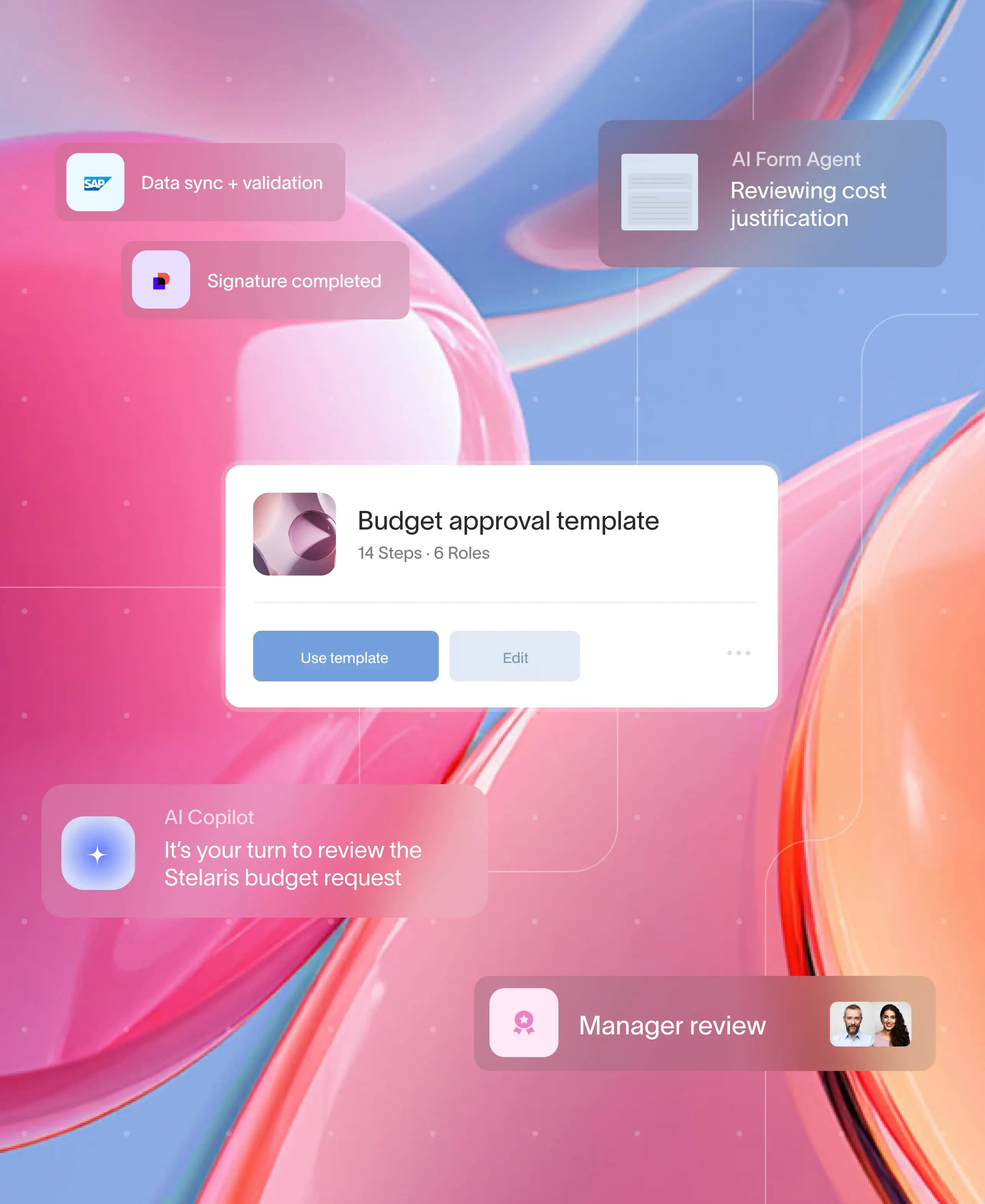
Businesses of every size rely on structured, workable processes. With shifting customer needs and market changes, even good processes can grow inefficient. By applying business process improvement methodologies, organizations spot and fix bottlenecks for better outcomes.
This guide covers the value of a process improvement framework, the difference between continuous improvement and process improvement, common methodologies for process improvement, and a roadmap to select the right approach. Keep reading to see how refined workflows reduce waste, save time, and enhance collaboration.
Why businesses thrive with a process improvement framework
A process improvement framework lays out a structured way to review and optimize workflows. It highlights important tasks that matter and others that waste resources. Streamlined processes keep teams on track and prevent confusion. Clear guidelines spur cooperation since each employee understands how tasks interlock from one department to another.
Refined process workflows boost agility when the market shifts. If demand rises for a certain product or a service, an adaptable system can handle changes without major slowdowns. This approach encourages cost savings because inefficiencies become more visible. Instead of repeating the same errors, a process improvement framework helps teams fix problems at the source.
By removing guesswork, a good business process improvement framework raises morale. Employees who see exactly where they fit in feel more motivated. Tasks flow logically, freeing everyone to spend more energy on innovation instead of administrative hurdles. Ultimately, effective processes make your organization more resilient and less prone to breakdowns.
Continuous improvement vs business process improvement: Discovering the differences
Both continuous improvement and process improvement revolve around making workflow better, but they focus on different layers:
- Continuous improvement is ongoing and pursues small, steady enhancements in any part of the business. Everyone is encouraged to propose upgrades and keep looking for the next step forward.
- Process improvement is a targeted effort to fix issues within a specific workflow. For instance, if you're onboarding timeline is repeatedly delayed, you analyze that workflow to uncover flaws and correct them.
Many organizations blend both. Continuous improvement keeps employees alert for new ideas. Process improvement zeros in on the most urgent or troublesome parts of daily operations.
Improvement methodologies
Choosing the right process improvement techniques depends on your goals and the nature of your workflows. Below are some best process improvement methodologies to consider:
Six Sigma
Six Sigma is a process improvement methodology that emphasizes the use of statistical tools to identify and reduce defects. With its DMAIC cycle (Define, Measure, Analyze, Improve, Control), it provides a structured approach that relies on data-driven decision-making.
Businesses that adopt Six Sigma see significant quality improvements, particularly in manufacturing and service sectors where precision is key. Organizations can further enhance Six Sigma by integrating it with other methodologies to address both large-scale issues and minor variations.
Lean
The Lean business process improvement method focuses on eliminating waste, i.e. anything that does not add value to the customer. This process improvement methodology is popular in production environments but has found success in administrative and service sectors as well.
Lean’s emphasis on value stream mapping helps organizations identify redundant steps and streamline operations. By involving team members in the continuous search for waste reduction, Lean cultivates a culture of efficiency that extends beyond the factory floor.
Kaizen
Kaizen’s process improvement framework is rooted in the philosophy of continuous, incremental improvement. It thrives on the involvement of every employee, promoting a culture where everyone is encouraged to find small ways to improve their work.
This approach is effective in dynamic industries where small tweaks can lead to significant cumulative benefits over time. Kaizen events or workshops can be instrumental in bringing teams together to brainstorm and implement practical changes.
PDCA
The PDCA (Plan, Do, Check, Act) cycle is a versatile business process improvement methodology that fits well with iterative development processes. By planning improvements, testing them on a small scale, checking the results, and then acting based on the feedback, organizations can steadily refine their processes.
PDCA is beneficial in scenarios where the environment is constantly changing, as it allows for frequent reassessments and rapid course corrections.
Additional business process improvement methodologies:
5 Whys
This simple yet powerful tool helps teams dig deep into the root causes of problems by asking “why” multiple times. It encourages critical thinking and prevents surface-level fixes.
SIPOC
Standing for Suppliers, Inputs, Processes, Outputs, and Customers, SIPOC diagrams offer a high-level view of the entire process, helping organizations understand all critical factors that influence outcomes.
5S
This process improvement methodology organizes workspaces to boost efficiency and reduce time wasted on searching for tools or documents.
Agile
Although widely used in software development, Agile’s iterative cycles and rapid feedback loops make it an effective approach in many business environments. Agile methods support quick adaptations to customer demands and market changes, ensuring that teams remain responsive and resilient.
Each of these process improvement methodologies brings unique benefits. Some are data-heavy, while others are more flexible. The final choice depends on your team’s goals, constraints, and project scope.
Adopting your preferred process improvement methodology
Introducing a new process improvement methodology doesn’t need to be overwhelming. Follow these steps:
- Identify your goals
- Form a cross-functional team
- Analyze current workflows
- Run a pilot test
- Measure outcomes
- Scale up and refine
- Sustain improvements
1. Identify your goals
Begin by defining clear, measurable objectives. For instance, determine if the focus is on shortening cycle times, reducing error rates, or lowering operational costs. Creating quantifiable benchmarks enables you to monitor progress accurately. Establish both short-term targets and long-term outcomes so that every team member understands what success looks like.
2. Form a cross-functional team
Assemble a diverse team that brings multiple perspectives. This team should include representatives from various departments to ensure that insights from every aspect of your business are captured.
Encourage open dialogue, and consider assigning roles such as project lead, data analyst, and process owner. Establish a clear communication plan to keep everyone informed throughout the project.
3. Analyze current workflows
Map your existing processes using flowcharts or digital mapping tools. Document each step, identify potential redundancies, and gather performance data. Conduct interviews or surveys with team members to uncover any hidden pain points or inefficiencies.
This comprehensive analysis helps in forming a baseline from which improvements can be measured.
4. Run a pilot test
Implement the proposed changes on a small scale to minimize risks. This phase is critical as it allows you to test assumptions and make necessary adjustments. Use the pilot to collect qualitative feedback and quantitative data. Analyze the outcomes carefully and be prepared to tweak your process improvement strategy before rolling it out company-wide.
5. Measure outcomes
Establish performance metrics to gauge the impact of the improvements. Use dashboards and regular status reports to track progress. Collect feedback from both internal teams and customers to gain a holistic view of the changes.
Compare the pilot data against your initial benchmarks to determine the effectiveness of the changes. Understanding how to measure operational excellence can provide useful metrics.
6. Scale up and refine
Once the pilot demonstrates success, develop a detailed plan for full-scale implementation. Include a timeline, resource allocation, and risk management strategies.
Ensure that every department understands its role in the new process. Provide training sessions, create documentation, and set up a support system for troubleshooting during the transition. Regular reviews and iterative adjustments will help the new process mature into a robust framework.
7. Sustain improvements
Finally, establish a continuous feedback loop. Set up periodic reviews and encourage a culture where employees suggest further improvements. By institutionalizing the review process, you ensure that the improvements are not a one-off project but become an integral part of your business strategy, fostering true operational excellence.
A practical process improvement framework to choose the right approach
Here’s how to home in on the best business process improvement methodology for your business:
- Match goals: If fast delivery matters, Agile might be a good fit. If cutting errors is your top focus, Six Sigma could be right.
- Check culture: Kaizen thrives on employee involvement, while others might be led top-down.
- Evaluate complexity: Lean or SIPOC can help if you have complex supply chains or multiple stakeholders. Consider the complexity of different types of business processes to improve.
- Review resources: Six Sigma often requires data skills. Simpler methods like 5 Whys might work better if you have fewer analytics tools.
- Consider timelines: PDCA or Agile lets you see quick improvements. More rigorous approaches may demand extra time.
Improving business processes with Moxo
Moxo is a comprehensive platform designed to streamline your business processes, boost productivity, and enhance client interactions. With a blend of automation, collaboration, and security features, Moxo transforms complex workflows into efficient, repeatable processes.
At the heart of Moxo is its intuitive, no-code workflow builder to build and design collaborative workflows to improve business processes. For example, you can fasten client onboarding and approvals, document collection, and digital signatures. By replacing manual tasks with automated workflows, Moxo helps you reduce errors, eliminate bottlenecks, and improve overall operational efficiency.
With enterprise-grade encryption and robust role-based access controls, your sensitive data is always protected. Moxo also offers seamless integration capabilities with popular business systems through native connectors, Zapier, and APIs, allowing you to incorporate your existing tools into one unified workflow.
In summary, Moxo equips your organization with the tools needed to adapt quickly, enhance collaboration, and achieve measurable improvements in operational efficiency. Whether you are looking to streamline client interactions or overhaul complex processes, Moxo stands as a strategic partner in driving business process improvement. Get started with Moxo today to reshape your workflows and delight your customers at every touchpoint.
Conclusion
Upgrading processes pays off by reducing waste, boosting team morale, and satisfying customers more reliably. The right process improvement methodology keeps your organization nimble in changing markets. Whether Lean, Six Sigma, or any other business process improvement methodology, a structured approach lets you tackle pain points systematically.
Moxo then elevates these gains by simplifying your digital workflows and creating a seamless client experience. Get started with Moxo today to reshape your workflows and delight your customers at every touchpoint.
FAQs
What if my team resists changes to established routines?
Encourage small, incremental tweaks first. This approach shows quick wins and helps the group see the benefits of an improved workflow.
Do these process improvement strategies apply to small firms?
Yes. Simple techniques like 5 Whys or PDCA can help small teams identify problems and fix them. Even minor changes can create big advantages.
Can I track ROI for a new process improvement framework?
Yes, you can track the ROI of a new process improvement framework. Compare performance metrics like product quality or customer response times before and after rolling out the changes. You can also measure cost savings over time.
Is expensive technology required to apply process improvement methodologies?
Not always. Some methods rely more on mindset and strategy than advanced tools. However, having user-friendly software for mapping workflows or collecting data can speed up improvements.





